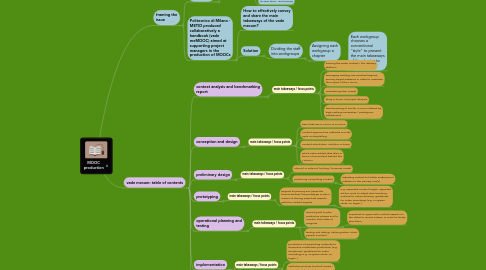
1. framing the issue
1.1. Why write a vade mecum on the MOOC production process?
1.1.1. to help project managers control the MOOC production process
1.1.1.1. to regulate the output quality of the MOOC
1.1.1.2. to prevent mistakes and failures
1.1.1.3. to apply best practices to similar situations
1.1.1.4. to save time....and money
1.2. Politecnico di Milano - METID produced collaboratively a handbook (vade meMOOC) aimed at supporting project managers in the production of MOOCs
1.2.1. How to effectively convey and share the main takeaways of the vade mecum?
1.2.2. Solution
1.2.2.1. Dividing the staff into workgroups
1.2.2.1.1. Assigning each workgroup a chapter
2. vade mecum: table of contents
2.1. context analysis and benchmarking report
2.1.1. main takeaways / focus points
2.1.1.1. framing the wider context / the delivery platform
2.1.1.2. leveraging existing communities beyond primary target audience in order to maximise the impact of the MOOC
2.1.1.3. considering FtoF events
2.1.1.4. thing in terms of project lifecycle
2.1.1.5. benchmarking of similar MOOCs offered by high-ranking universities / prestigious institutuions
2.2. conception and design
2.2.1. main takeaways / focus points
2.2.1.1. basic features cMOOC vs xMOOC
2.2.1.2. content approach ex cathedra vs Kolb cycle vs storytelling
2.2.1.3. content articulation: modular vs linear
2.2.1.4. which value-added idea (also in terms of innovation) behind the MOOC?
2.3. preliminary design
2.3.1. main takeaways / focus points
2.3.1.1. internal vs external funding / business model
2.3.1.2. producing compelling content
2.3.1.2.1. adjusting content to further audiences in addition to the primary one(s)
2.4. prototyping
2.4.1. main takeaways / focus points
2.4.1.1. beyond its primary aim (does the format works?), the prototype is also a means of sharing important aspects with the content experts
2.4.1.1.1. e.g. expected content length, expected ad-hoc work to adjust FtoF teaching material to online delivery; guidelines for video recordings (e.g. no green shirts, no logos..)
2.5. operational planning and testing
2.5.1. main takeaways / focus points
2.5.1.1. shared gantt to plan producton phases and to monitor their state of progress
2.5.1.1.1. important to agree with content experts on the dates to record videos, in order to timely plan them
2.5.1.2. testing and debug: defining when, what, people involved
2.6. implementation
2.6.1. main takeaways / focus points
2.6.1.1. production of supporting materials to streamline multimedia production (e.g. storyboard, guidelines for video recordings e.g. no green shirts, no logos..)
2.6.1.2. validation process (content review - correction - final validation by content experts)
2.6.1.3. additional materials (e.g. self-assessment quizzes, polls..)

